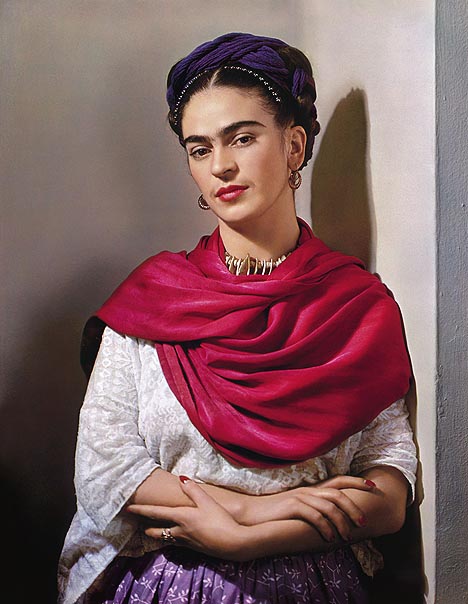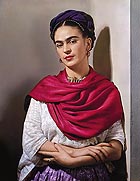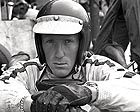
translated and summarized by: Liz Wollner-Grandville,
English summary September 6 - 12
ZKM – Zentrum für Kunst und Medientechnologie
Jürgen Klauke – Aesthetic Paranoia
13.05.10 – 03.10.10
Tangled wires and other neuroses
Italy had Luigi Ontani, Switzerland had Urs Lüthi, Austria his Attersee, and in Germany it was Jürgen Klauke, and the list could go on and on. In the 1960’s and 1970’s, all of these beautiful young gods positioned themselves, androgynous as well as lascivious, in the centre of attention – in an unusually shrill way. Later, the oeuvres and careers of those mentioned developed into very different directions. In addition to creating video installations, Klauke remained loyal to photography.
With “Aesthetic Paranoia” the Karlsruhe ZKM devotes itself to Klauke’s most recent works. Klauke preferred to define himself as an artist rather than as a photographer, and utilized photography for his (self) stagings. Over the years, the shrillness of former travesties have given way to a reduced austerity, which uncover the abysms of human existence just the same. Sockets and cable connections attain a unique aesthetic form; if a human being appears on the scene, he is only a lonesome jumping jack in the technical environment.
In the title-giving series, a wig with very long hair, seemingly never-ending, is thrown onto the level of a bed with white linen. At some point, the carefully arranged sight- as well as face-covering streaks end wildly messed up on the sheets, and one would like to see it as a triumph of reality over illusion.
As much as the forcefulness of these new works, whose depth and saturated blackness are only lightened up by the few white requisites and highlights, impress the onlooker, one is surprised about the only colour series titled “Battlegrounds”. Some splashing red colour, a great deal of gaping animal mesentery, not that Hermann Nitsch or Heinz Cibulka have the monopoly on this, but somehow this work does not really fit. Lets wait and see what others say to the guts-show, which will be presented at the Salzburg Museum der Moderne as of October 23.
By Daniela Gregori
ZKM – Zentrum für Kunst und Medientechnologie
www.zkm.de
Bank Austria Kunstforum
Frida Kahlo
01.09.10 – 05.12.10
Stunning icon of modernity
Already prior to the Frida Kahlo retrospective at Vienna’s Bank Austria Kunstforum, the Kahlo-cult in the media was unusually intensive.
The phenomenon of the enormous public attendance, something that even took the marketing department of the Martin-Gropius-Bau in Berlin by surprise, obviously cannot be ignored. The retrospective in Berlin, to which people travelled from far away and queued for up to 8 hours making the exhibition one of the best visited of all times, lets us wonder what constitutes the legend Kahlo.
One part is the emancipatory dimension of Frida Kahlo’s self –empowerment to position herself as an icon. From this point of view, the photographs on which she is depicted are especially interesting. Admittedly, her stiff posture is mainly connected to the spinal injury, but among these works are also staged photographs in which Kahlo directed her own performance – especially in Nicolas Murray’s photographs.
In addition to her stylisation as a feminist artist – particularly since the 1970’s - one must also keep in mind that she belonged to an intellectual elite, in which leftist, revolutionary politics and artistic avant-garde cultivated a very personal exchange. One of the photos displayed in Berlin speaks volumes. On the photo: Leo Trotsky, who fled to Mexico, and a friend of Kahlo’s. Next to Kahlo: Diego Rivera and André Breton. Who would not have liked to participate in their conversation!
Kahlo’s art does was not dwarfed by any of this. One often encounters an odd contrast between fairytale-like popularity and magical image-inventions on the one hand, and rudiments of strategies of modernity pointing into the direction of independence of form and colour on the other. This mixture may at times be disconcerting, but Kahlo’s paintings can be interpreted in the tradition in which artists repeatedly depict their own portrait, e.g. Dürer. Indeed - Kahlo narrates
her sufferings in her paintings (caused by a bus accident), but behind all of this lie stringent processes of formalisation.
It would be dubious if the success of Kahlo’s exhibition would mainly be ascribed to her seemingly obvious biographical narrative. In any case, it is worth queuing for the exhibit. On account of the enormous organizational effort these kinds of retrospectives are rare. Should one have to queue, one could start reading the gripping and enlightening catalogue. Yet it does not include enough historical details. Why one eloquently points to the stereotype pop star image ascribed to Kahlo, but writes so little about post-revolutionary Mexico, its cultural understanding, the art scene, and the general conditions for women, is incomprehensible.
By Roland Schöny
Bank Austria Kunstforum
www. kunstforumwien.at
Westlicht. Schauplatz für Fotographie
Jochen Rindt, the first Formula 1 pop star
03.09.10 – 26.09.10
In the headlights of fame
Automobile lights are made to help us find our way in the dark. The better the light, the faster one can drive – or the car is driven by someone who finds his way blindly, anticipates all curves in his blood and drives accordingly.
Jochen Rindt was this type of driver otherwise one would not commemorate the 40th anniversary of his death with 140 photographs at the Westlicht; thereby making him the first pop star of Formula 1. Unconditional prerequisites of a pop star are the qualification of becoming an icon, shining in the spotlight and glamour. Among the most glamorous characteristics of a pop star is adoration. Marilyn Monroe was the first icon of pop and Jochen Rindt, with his appealing cheekbones in combination with his lips and his eyebrows, was similarly photogenic. She was sexy - and so was he. Andy Warhol painted her; Austria built two racetracks for him. She sang for J.F.Kennedy. He received a laurel wreath from Grace Kelly.
Both of them died young, like James Dean, Caravaggio and Wolfgang Amadeus Mozart and many more. Some might say: the gods loved them. They became even more famous although they were no longer alive. They were convincing in what they did or in what they wanted to be. Glamour can be extremely cool. Glamour, as a personal characteristic, could be compared to being born with a "long light" – photogenic at that. Photographically documented icons might have the virtue to age less or more visibly than the rest and possibly form the largest stored youth image reservoir of the world.
The vocabulary of the glamorous poise on the photos with Jochen Rindt, no matter if with a crocheted protection mask or with his fur coat in front of a block hut, or even with a patch over a pimple beneath his right nose wing - all seem worthwhile seeing. In addition, two films let the legend shine and one is invited to be amazed, astonished and maybe even bittersweet by drivers, headlights, Lotus, breaks, and other attractions.
By Charles Nebelthau
Westlicht, Schauplatz für Fotografie
www.westlicht.com
The Geffen Contemporary at MOCA
Dennis Hopper – Double Standard
11.07.10 – 26.09.10
“Hey, that’s a painting!”*
The Large letters mounted on the gas station read “DOUBLE STANDARD”; written twice they give the building a mirror-effect. The photo was taken from behind a windscreen – and in the car’s back mirror another windscreen is visible – as a front view. And “DOUBLE STANDARD” also stands for Dennis Hopper’s oeuvre both in art and film.
In the exhibition catalogue, Julius Schnabel, curator and Hopper’s long-time friend, writes: “Hopper shot photos like someone who was constantly on the lookout for paintings, as if he would call out: “Hey, that’s a painting”.”
This not only describes his earlier works, but also his recent works: the huge paintings, photorealistic works of his friends including “James Rosenquist” (with Brunette Billboard, 2009), Roy Liechtenstein and Andy Warhol (with flower, 2006) appear like oversized photos or blowups.
The exhibition is described as “the first comprehensive survey exhibition of Dennis Hopper’s artistic career”. With the one-month retrospective of his films at the LA Film Forum, running at the same time, the exhibition offers the essence of both parts of his art world.
The works are very carefully selected, and some of them were displayed at the MAK exhibition in Vienna in 2001, such as “Drop Bomb” (1967/68/2000), the backlit sculpture of an enlarged bomb release lever or “Hotel Green Entrance” (1963).
Schnabel, through his selection, shows that Hopper was a fantastic artist – one who also happened to be successful in Hollywood. Double Standard, at that.
His beginnings in the 50’s show his involvement with the pre-war generation, with surrealism. In his works, in which he combines objects and painting, he takes up the game with reality and its doubling-effect through depiction. He does the same in his series of J.F. Kennedy screenshots (1967) or when he combines painting with film: e.g. in the triptych in which the sequence of an accident is projected onto the middle of the canvas the moment the onlooker presses the projector’s lever; or the “real” parts of American fences and house facades. His oversized advertising figures, the “Salsa Man” (2000) and the “Mobile Man” (2000), or the life-size Cowboy, illustrate what constitutes America: food and gasoline. And legends.
He used all kinds of media with their degrees of reality and let them interact with one another. The same way he had to “get to terms with” the cross fading of his own reality in the world of film.
Dennis Hopper lived the “American Dream”, he was a part of it and his art centred on the topic. He was a member of the California School of Assemblage and New Realism and was the co-founder of conceptual art together with Ed Rusha and Edward Kienholz. In his Hollywood films, Hopper was influenced by experimental film. Too bad, that until now the Hollywood glamour “overshadows” Hopper’s standing as a visual artist.
By Renate Quehenberger
*taken from the catalogue text “A reflection on Dennis Hopper as an artist” by Julian Schnabel in “Dennis Hopper DOUBLE STANDARD”, MOCA, 2010-09-11
The Geffen contemporary at MOCA
www.moca.org
Mehr Texte von translated and summarized by: Liz Wollner-Grandville


 Teilen
Teilen




